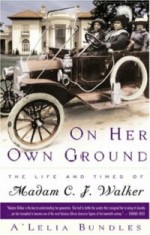
As February comes to a close, Black History Month gives way to Women’s Month, and Madam C. J. Walker comes into her own. As a self-made African-American woman who lived at the turn of the century, her story of rags-to-riches success is one whose appeal crosses racial and gender lines.
On Her Own Ground: The Life and Times of Madam C. J. Walker is researched and written by A’Lelia Bundles, Walker’s great-great-granddaughter. Owing to Madam Walker’s extensive network of correspondents within the African-American community, the biography is better documented than many narratives of this time period, and a good 100 pages at the end are devoted to bibliography and acknowledgments. Bundles has certainly done her homework, and her recreation of her ancestor’s life shows remarkably few gaps.
Like most African Americans in the rural South in the years following the Civil War, Madam Walker (née Sarah Breedlove) began her life in a primitive cypress cabin surrounded by ignorance, poverty, and the prospect of a lifetime of drudgery. The first of her parents’ five children not born into slavery, she came into the world not much better equipped than they to deal with the resentment and retaliation of a still-seething America.
Orphaned at seven and married at fourteen, Sarah’s life began to take shape with almost frightening speed. In quick succession, she became a mother at seventeen and a widow at twenty. Working long, arduous hours as a washerwoman to support herself and her young child, Sarah eked out an existence in the rough neighborhoods of St. Louis, Missouri, braving violence and prejudice in the hopes of creating a better life.
With a writer’s instinct for the dramatic, Bundles sketches her great-great grandmother’s struggles in vivid detail:
“Because nothing in Mississippi had prepared Sarah for the riptide of the city, she was sucked under again and again by family tragedies, an abusive marriage, a dangerous neighborhood. Finally the resilience she had first mustered after her parents’ deaths reemerged. As she set about to reinvent herself, she began to erase relationships and events too painful and shameful to acknowledge.”
This rewriting of personal history would continue for the rest of her life, as Sarah, assisted by (and burdened with) her third husband, C. J. Walker, began to ascend the social ladder. The key to her success lay in a bottle of hair treatment that strengthened dry, brittle hair and caused it to grow (or at least not fall out, and so get thicker).
Like most of the pharmaceutical products available in the early twentieth century, Madam C. J. Walker’s Wonderful Hair Grower relied heavily on superlative advertising and fantastic claims; the difference was that, unlike many of her competitors’ concoctions that either did nothing or actually harmed the user’s hair, Walker’s mixture actually worked. Consequently, her ads also prominently featured testimonials and her sales campaigns were based around free demonstrations. Having restored her own hair through use of the miraculous Hair Grower, Walker often proved to be her own best advertisement.
With the post-war advent of a new black middle class, the market for Walker’s hair care system took off. From the very beginning, her earnings rose exponentially from the $20 or so she had been accustomed to receiving as a washerwoman every month, and in 1909, three years after she began selling Madam C. J. Walker’s Wonderful Hair Grower, Walker earned $8,782, or over $150,000 in today’s dollars. That was only the beginning. Throughout her life, she made a name for herself as a philanthropist and social activist, meeting with legendary figures like Booker T. Washington and W. E. B. Du Bois. Although On Her Own Ground is primarily about Madam Walker, Bundles also tells the story of Walker’s daughter, A’Lelia, for whom she is named. Carrying on the family tradition, A’Lelia earned her own prominence in the Harlem Renaissance as a celebrated hostess and a friend to both Langston Hughes and Zora Neale Hurston.
Bundles’ enthusiasm for her subject is unmistakable, and she takes great care to leaven historical data with personal triumphs and struggles. For a book that is a straight biography of a monumental figure in both African American and women’s history, On Her Own Ground often tends to read like a novel. The story is not interrupted by myriad footnotes and references, and attributions are subtle and integrated into the text. One advantage to this book is that it contains eight pages of pictures, ranging from formal portraits of Madam Walker to shots of her factories, cars, friends, and protégés.
In the end, On Her Own Ground is the story of one woman’s rise to international prominence without the assistance afforded by wealth or existing social class, but through her own ambition, perseverance, and unrelenting desire to change the way that women and blacks think of themselves.






